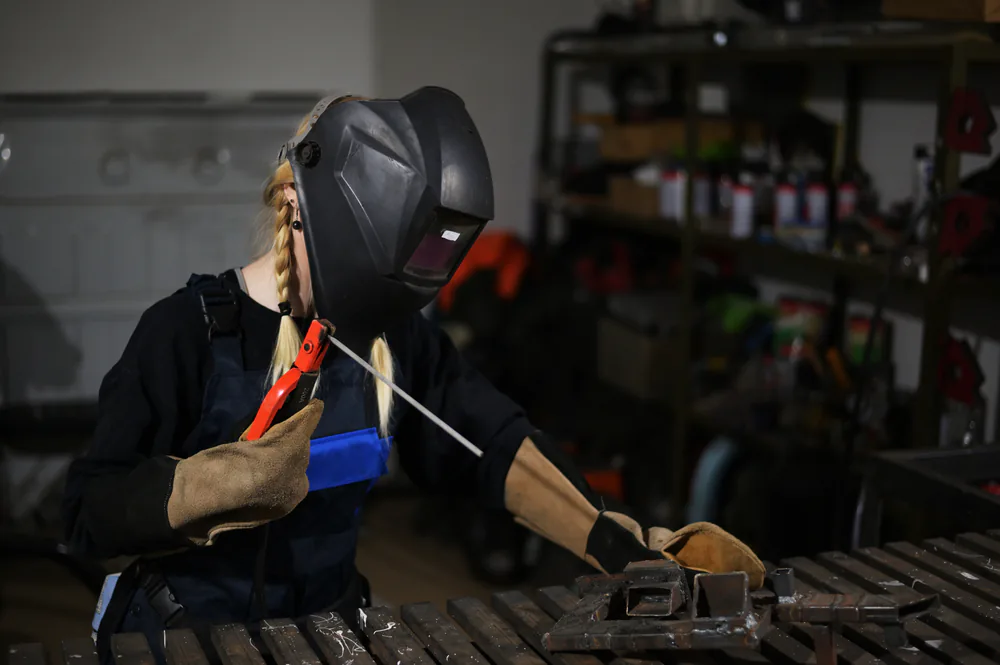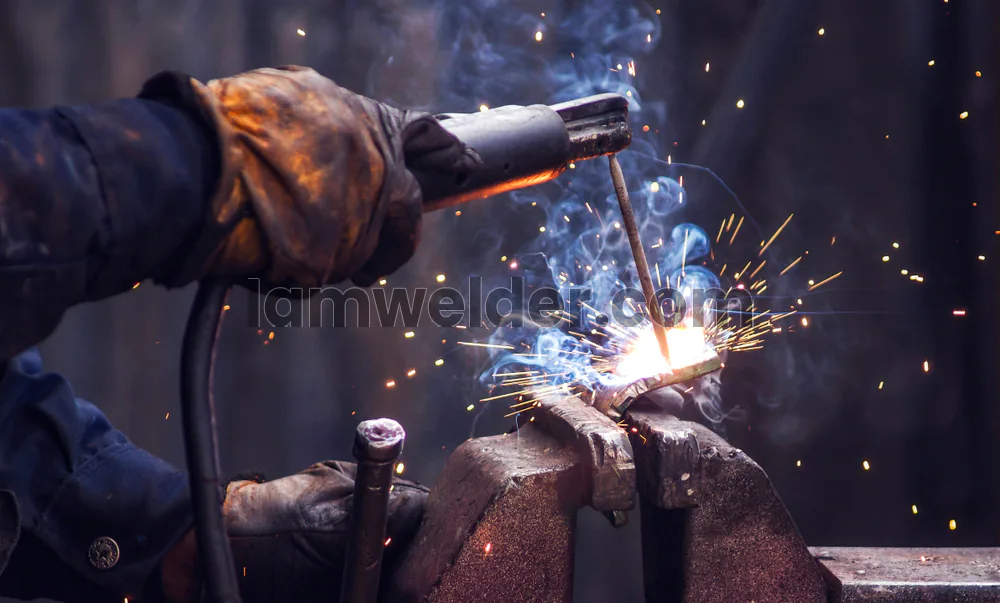Informational
Welding Union 101: Everything You Need to Know

So, you’re likely curious about welding unions. Maybe you’ve heard the buzz around town or are just starting in the welding world and want to know your options. Either way, you’re in the right place.
A welding union is like a big family of welders and trade professionals. Their main goal is to ensure that welders like you and me get the best working conditions, fair Pay, and proper representation when dealing with big companies.
In the coming paragraphs of this article, we’ll dive deep into everything you need to know about welding unions, from what they are and the benefits of joining one to the nitty-gritty of becoming a member.
So, grab your welding helmet, and let’s get started!
What is a Welding Union?
In simple terms, Welding unions form a closely knit community of skilled welders and trade professionals, akin to an extended family.
Their primary mission revolves around securing optimal working conditions, equitable remuneration, and effective representation for welders, just like you and me, especially in negotiations with prominent corporations.
Think of them as the middleman, ensuring your rights are protected, and your voice is heard.
But it’s not just about negotiations and contracts; it’s about building a community where welders can share experiences, learn from one another, and grow in their careers.
Union Welder vs. Non-Union Welder
The age-old debate to join a union or to go solo? While both have pros and cons, it often boils down to personal preference.
Let’s break it down:-
Union Welder Pros
- Job Security:- Unions often provide better job security.
- Higher Pay:- Union welders typically earn more.
- Benefits:- Access to health, dental, and retirement benefits.
Union Welder Cons
- Union Dues:- Monthly or annual fees.
- Less Autonomy:- Might have less say in job assignments.
Non-Union Welder Pros
- Flexibility:- Choose your projects and clients.
- No Dues:- No need to pay union fees.
Non-Union Welder Pros
- Less Job Security:- Might face more competition.
- Potentially Lower Pay:- Might not have the bargaining power of a union.
“The choice between union and non-union is personal. It’s about what aligns with your career goals and values.” – Bakers Gas
Comparison Table
| Criteria/Aspect | Union Welder | Non-Union Welder |
|---|---|---|
| Representation | ✅ | ❌ |
| Wages | ✅ | ❌ |
| Health Benefits | ✅ | ❌ |
| Training | ✅ | ❌ |
| Job Security | ✅ | ❌ |
| Work Freedom | ❌ | ✅ |
| Membership Cost | ❌ | ✅ |
| Job Placement | ✅ | ❌ |
| Safety Standards | ✅ | ❌ |
| Future Trend | ✅ | ❌ |
| Bargaining Power | ✅ | ❌ |
✅ indicates a favorable aspect for the respective category, while ❌ indicates a less favorable or absent aspect.
Benefits of Joining a Welding Union
1- Enhanced Job Security
You’re not just another employee with a union. You’re part of a family that ensures fair treatment, especially when things get tough.
Unions work tirelessly to negotiate for better wages, benefits, and working conditions, providing enhanced job security and stability.
2- Ensured Safe Working Environment
Welding can be risky, but you can ensure your safety is a top priority with a union. Unions collaborate with employers to establish stringent safety protocols, provide proper training, and meet safety standards.
This lets you focus on your craft with peace of mind, knowing that your well-being is being looked after.
3- Higher Pay and Recognition
It’s no secret union welders often earn more than their non-union counterparts. Collective bargaining by the union enables welders to negotiate for better wages, recognition of their skills, and additional perks that reflect their dedication to the profession.
A union welder makes an average salary of $40,000 per year. This amount includes salaries, benefits, and overtime, potentially increasing the take-home Pay.
4- Strong Representation
Within a welding union, every member’s voice matters. Unions act as powerful representatives during negotiations with employers, ensuring that your interests are heard, and your opinions count.
This collective strength allows welders to significantly impact decisions that affect their work, wages, and future.
5- Thriving Welding Community
Being part of a welding union means joining a thriving community of like-minded individuals who share your passion for welding.
It provides an excellent platform to connect with fellow welders, share experiences, exchange ideas, and learn from one another. This sense of camaraderie can be invaluable in both personal and professional growth.
6- Protection of Rights and Safety
A welding union serves as a formidable shield, protecting your rights and safety. By advocating for better working conditions, fair treatment, and equitable opportunities, the union ensures that your professional journey remains smooth and free from exploitation.
Some of the Drawbacks to Joining the Welding Union
1- Financial Commitments: Union Dues, Fees, and Potential Lost Wages
Members must pay union dues and fees supporting the union’s operations. While these funds are essential for union activities, there’s criticism regarding their use, especially when union leaders receive high salaries.
Additionally, union activities, such as strikes, can lead to lost wages for workers during the strike period.
2- Workplace Dynamics: Tension, Slower Advancement, and Employer Pushback
Union activities can create workplace tension, affecting relationships between union and non-union workers and between workers and management.
In some unionized settings, promotions are based on seniority rather than merit, potentially slowing the advancement of high-performing workers.
Furthermore, employers often resist unionization, leading to aggressive anti-union campaigns.
3- Loss of Individual Autonomy and External Interference
Being part of a union means adhering to collective decisions, even if an individual member disagrees, leading to a perceived loss of Autonomy.
Some also view unions as external entities interfering with the company’s internal dynamics and operations.
4- Economic and Operational Challenges: Impact on Competitiveness and Risk of Job Loss
Critics argue that union rules can reduce a company’s flexibility and competitiveness, especially compared to non-unionized companies with lower labor costs.
The increased costs associated with union demands can also lead to potential layoffs, outsourcing, or even business closures.
5- Uncertainty and Potential for Corruption
Unionizing introduces uncertainty, especially during contract negotiations, without guaranteeing better terms.
Like any organization, unions can face corruption issues, where union leaders have been involved in corrupt practices, affecting the union’s reputation.
What Kind of Unions Should You Join?
The world of welding is vast and varied, as are the unions.
Depending on your specialization and interests, you might find yourself leaning toward one of these:-
1-Pipefitters
Ever wondered who ensures that the plumbing in skyscrapers or residential buildings is top-notch?
Enter the Pipefitters. These specialists work with plumbing and welding pipes, ensuring that everything from your home’s heating system to the complex cooling systems in commercial buildings is in perfect shape.
Work Areas:-
- Designing and installing plumbing systems.
- Repairing and maintaining pipes.
- Collaborating with construction teams to ensure plumbing integrity.
2-Boilermakers
These are the heavy-duty guys. Boilermakers are the backbone of industries like construction, manufacturing, and shipbuilding.
Their role is indispensable, from building massive boilers that power industries to ensuring they run smoothly.
Work Areas:-
- Construction sites.
- Manufacturing units.
- Shipbuilding yards.
3-Ironworkers
From the majestic bridges that connect cities to the high-rise buildings that touch the sky, ironworkers play a pivotal role in shaping our urban landscapes.
They work with metals, primarily iron and steel, to create structures that are not only strong but also aesthetically pleasing.
Areas of Work:-
- Building bridges.
- Assembling structural frames.
- Constructing commercial buildings.
Educational and Certification Requirements to Join the Welding Union
To join the welding union, the following educational and certification requirements are typically expected:
1-High School Education
Most welding unions require at least a high school diploma or its equivalent. This is often the basic educational requirement to get started in the field.
2- Welding Certificate, Diploma, or Associate Degree
After graduating high school, aspiring welders should consider obtaining a welding certificate, diploma, or associate degree. Some employers and unions might not strictly require these, but having them can enhance one’s qualifications and chances of joining a union.
3- Welding Apprenticeship
Many unions and employers value hands-on experience. Participating in a welding apprenticeship program allows individuals to gain practical experience while receiving classroom training.
These apprenticeships can be affiliated with unions or independent organizations.
4- Welding Certification
Some welding unions may require a welding certification from a recognized certifying organization, such as the American Welding Society (AWS).
The specific certification requirement can vary based on the type of welding work involved. For instance, there are different certifications for MIG welding, TIG welding, underwater welding, etc.
5- Physical Fitness
Since welding can be physically demanding, some unions might have physical fitness requirements or tests to ensure members can safely perform their duties.
6- Background Check
For security reasons, some unions might require applicants to undergo a background check, which could include a criminal background check.
Steps to Join a Welding Union
Alright, let’s get down to business. If you’ve decided that a union is the way to go, here’s what you need to do:-
1- Get your welder’s certificate.
Before anything else, you need to be certified. Organizations like the American Welding Society (AWS) offer certifications recognized internationally.
It’s your ticket to proving your skills and expertise.
Steps to Certification
- Training:- Enroll in a recognized welding training program.
- Examination:- Pass the AWS certification exam.
- Renewal:- Keep your certification updated with regular renewals.
2- Look for a welder’s union
Do your Research. Each union has its own set of benefits, requirements, and cultures.
Find one that aligns with your goals and values.
Tips for Research
- Ask Around:- Talk to fellow welders and get their insights.
- Online Research:- Check out articles like this one for more information.
- Visit Union Offices:- Get a feel for the community and ask questions.
3- Apply to the welder’s union.
Once you’ve made your choice, it’s time to apply. Reach out, ask questions, and ensure you understand the process.
Application Tips
- Prepare Your Documents:- Ensure you have all necessary certifications and IDs.
- Interview:- Some unions might have an interview process. Be prepared to discuss your experience and aspirations.
- Stay Patient:- The process might take time, but it’s worth the wait.
Frequently Asked Questions (FAQs)
Navigating the world of welding unions can be a maze of questions.
Here, we’ve tackled some of the most burning ones to give you a clearer picture:-
What exactly is a welding union?
A welding union is formed by welders and trade professionals to safeguard their collective rights and enhance working conditions. They act as intermediaries during salary negotiations and address workplace issues.
How does a welding union differ from other trade unions?
While the core principles remain the same, welding unions specifically cater to the needs and challenges faced by welders. They focus on safety protocols, specialized training, and fair Pay in the welding industry.
Are welding union fees worth it?
Absolutely! While there’s a fee involved, the benefits you receive in terms of job security, higher Pay, and a safe working environment often outweigh the costs. This Peace Health Platform article delves into the benefits in detail.
Can I join a welding union if I’m self-employed?
Many self-employed welders join unions to benefit from collective bargaining, networking opportunities, and continuous skill development.
How do I choose the right welding union for me?
Research is key. Understand the benefits each union offers, their industry reputation, and current members’ feedback. Choose one that aligns with your career goals and values.
Conclusion
Embarking on a welding career is an exhilarating journey filled with sparks, metals, and endless opportunities.
And while the flame and the arc are crucial, so is ensuring that your rights, growth, and well-being are prioritized. That’s where welding unions shine.
They’re not just organizations but communities, support systems, and advocates rolled into one.
Whether you opt for the union route or go solo, the welding world is vast and welcoming. It’s a realm where skill, passion, and dedication are the cornerstones.
So, as you gear up, remember to stay safe, stay informed, and never stop learning. The world of welding awaits, and it’s bound to be a thrilling ride!

Informational
How to Weld If You Have Long Hair? Pro Welder’s Tips

Any welding operation that you perform puts you and anyone else in the area in danger of a number of different things. As a result, it is completely reasonable for you to be concerned about preventing your hair from becoming entangled in any welding equipment and posing a threat to your health. In this article, I will talk about how you can safely weld if you have long hair.
If you want to weld while having long hair, a French braid is the best option for keeping your hair together. This will help you in tying your hair and hold it together behind your neck. The French braid should keep the hair compact and close to your head’s shape, and it also allows you to wear a welding helmet. As a result, you will be able to wear full safety equipment.
When you are dealing with hot weld spatters, having long hair can present a particularly difficult challenge. Therefore, if you are interested in learning more about how you can safely weld with long hair, continue reading the rest of this article, where I will discuss the topic in greater detail and share some helpful hints.
How Your Long Hair Can be an Issue While Welding?
Welding procedures, as I indicated earlier, expose the operator as well as anybody else in the vicinity of the workplace to a wide variety of risks. A project involving welding presents a number of potential dangers and threats; it is important that you be aware of these issues in order to protect not only yourself but also others around you. Especially when dealing with spatters, it is easy for things to go wrong if you have long hair.
Before we look at all of the tips you may weld with long hair, we need to first understand the potential risks you run and everything that might go wrong. Long hair poses a unique set of challenges when it comes to welding. A few are mentioned below:
- Spatters are your hair’s worst enemy.
- UV rays can permanently damage your hair.
- With long hair, grinders can cause serious accidents.
Let’s look at these problems one by one:
1. Take Spatters Seriously
The spatter, sparks, and heat generated by the arc provides the greatest challenge throughout the welding process since they may travel up to 35 feet and enter any nearby place. You will want to provide enough protection for your long hair if you are going to be in an atmosphere like this.
Not just your hair, but everything else that might catch fire should be kept at least 35 feet away from the welding location. In addition, a fire extinguisher should never be far away. In the event that a fire breaks out.
2. UV Rays Can Damage Your Hair Permanently
Molten metals, welding arcs, and ultraviolet radiation will be present in the work environment while welding is being done. The interaction of all these factors puts you at an increased risk of serious burns. The actual welding arc may reach temperatures of up to 10,000 degrees Fahrenheit, making it one of the hottest processes possible.
And believe me when I say that you do not want that welding arc to get anywhere near your hair. Your hair will suffer a significant amount of damage as a result, and it is possible that it could even be burned.
3. Grinder Can Give You Nightmares
The usage of grinders is another factor that may create issues for your lengthy hair. Using grinders and welding go hand in hand when working with metals. Therefore, if you are a welder, you will most likely make extensive use of the grinder. And grinders are really your worst enemy when it comes to your long hair.
When you’re working, you can find yourself crouching over a grinder, which can cause serious accidents if you don’t protect your hair properly.
Tips from a Pro Welder to Protect Your Long Hair When Welding
Now you know what the most obvious dangers that you have when welding with long hair. The next step is to tell you how you can keep yourself safe from those dangers.
Here are a few of the tips that you can consider:
- Braid your hair while welding
- Put your hair in a tight knot behind your neck
- Consider buying a welding cap
- You can use a bandana too if you are a bandana lover
Let’s discuss these tips one by one:

1. Braiding is the Best Option You Have
Welding hoods, helmets, or shields will provide the optimum amount of protection from any sparks, heat, UV rays, flash burns, or infrared light that may be present. They will protect not only your face and neck but also your eyes and hair. As a result, I feel that acquiring one is the best approach to protecting oneself.
Welding hoods are often made of cotton or leather and are rather light in weight and can go easily along with helmets. Make sure that whichever helmet you decide to purchase, is not too heavy and that it is comfortable to wear. It must also include a spatter barrier, the ability to be modified, a sensor bar, and the availability of replacement components.
2. You Can Simply Put Your Hair in a Tigh Knot
The most conventional and easiest technique for a welder operator to keep their long hair out of their face is to pull it back into a tight bun. Wrap an elastic band over your buns and secure them in place to prevent them from falling on your face.
If there are any unruly hairs, just use bobby pins to push them up and you should be OK. Anything that prevents your hair from falling on your face will suffice.
3. Consider Buying a Welding Cap
A welding cap is a good option if you want something that is both lightweight and comfortable. It must adequately shield your head from any hot metal, sparks, or splatters that may be present.
Not only they are effective in protecting your hair, but they are also made completely of cotton, making them incredibly breathable and also preventing sweat from pouring down your eyebrows while working.
4. Bandana is Another Option That You Can Use
Braids are not easy to create for everyone, and they may even be difficult to perform on a regular basis. If you don’t know how to braid my easiest suggestion would be to put a bandana over your head and tuck all of your hair within.
When welding, sparks will fly everywhere, and this will keep you safe. Make use of bobby pins or a bun to tuck in all of the ends. Bandanas aren’t my first choice for headgear. But it works. It’s a good option to have in case you don’t know how to braid your hair.
Few Other Safety Measures That You Need to Take
In addition to your hair, there are a few other parts of your body that need your attention. Some of these essential measures for ensuring your safety are listed below:
- Protect your eyes at all cost
- Always keep a fire extinguisher in your shop
- Wear protective clothing
- Make habit of using respirators
- Beware of leakages in your welding system
- Keep your welding space clean
Let’s discuss them one by one:
1. Protect your eyes at all cost
Be sure to always wear safety glasses in your workplace to protect your eyes from flying debris, which is often composed of metal. If you routinely do welding tasks, you will be exposed to a significant amount of flying debris.
You should make it a routine to put them on as soon as you come in the door; this will ensure that you are protected at all times.
2. Always keep a fire extinguisher in your shop
You shouldn’t be shocked if anything catches fire at some time during a welding operation because of all of the intense heat and sparks that are produced throughout the process. Because fires are a very real risk, you should always have an extinguisher on hand in case one breaks out.
3. Wear protective clothing
If you’ve ever imagined yourself beginning your first welding project in a pair of shorts, an old t-shirt, and a pair of flip-flops, you should rethink that idea. Wearing the necessary protective clothing at all times when welding is required if you wish to prevent injuries to your body, notably burns, that may be caused by the process.
4. Make habit of using respirators
You should always wear a respirator if you are going to be dealing with metals or any other materials that have the potential to emit harmful vapors.
Welding or cutting certain materials may produce a welding plume, which is a combination of hazardous gases, fumes, and smoke. This is not the type of thing you want to breathe in if you want to keep your lungs healthy and prevent respiratory issues.
5. Beware of leakages in your welding system
There is a good chance that you have pressurized containers in your welding shop that hold liquids or gases. Take extra precautions to check that none of those containers or the items that you are attaching to them have any leaks in them.
See my other article to know more about leakages and how to detect them.
6. Maintain your equipment
If you want to establish the safest possible working environment for your welding projects, you need to give your equipment a lot of TLC and make sure it’s in good operating order at all times. If your welding equipment and tools are in disrepair, an accident is almost waiting to happen every time you use them. However, the vast majority of incidents of this kind are avoidable if proper care is taken with the equipment.
Wrapping it Up
When it comes to welding, safety is the most important thing to keep in mind at all times. Because because welding involves a significant amount of fire and spatters, it is essential that you take a significant amount of precaution to protect your hair. I really hope that you’ll be able to keep your hair under control while welding thanks to the advice that’s been provided in this article.
Weld Types
Different Welding Methods: Applications of Each Method

Welding is joining two pieces of metal together by melting and cooling them until they become one piece. Welding processes include:
- Oxyacetylene welding
- Shielded metal arc welding (Stick)
- Gas tungsten arc welding (TIG)
- Gas metal arc welding (MIG)
- Flux-cored arc welding
- Torch or oxyfuel brazing
Some methods employ both heat and pressure, while others employ only heat. Welding is commonly used to construct automobiles, airplanes, and buildings. Other metal-cutting methods, such as oxy-acetylene and plasma arc cutting, use heat or electricity to cut through metal.
1. Oxyacetylene welding
Oxyacetylene welding (OAW) is a method of joining two pieces of metal using heat generated by the combustion of oxygen and acetylene gas.
Torch brazing (TB) is similar, but the metal is not completely melted. Instead, a special alloy is melted and used to join the two metal pieces.
Oxyfuel gas cutting (OFC) is a method of cutting metal that uses the same tools and gases as OAW and TB.
To generate heat and bond the metal, all of these methods employ a torch and special gases. They are frequently used on small or thin metal pieces.
Applications:
- Welding and brazing thin or small pieces of metal
- Welding and brazing dissimilar metals
- Cutting and piercing metal
Situations to Avoid:
- Welding thick or heavy sections of metal
- Welding high alloy or stainless steel
- Welding in high wind or outdoor conditions (due to the open flame)
- Welding in confined spaces (due to the production of harmful gases)
2. Shielded metal arc welding (Stick)
Shielded metal arc welding, or SMAW, is a way of welding metal together using an electrode that is coated with a special kind of flux.
The electrode melts and becomes a part of the welded metal. To do SMAW welding, you need a transformer, two welding cables, a work clamp, and an electrode holder.
There are many different types of electrodes you can use for SMAW welding, so you can choose the one that is best for your project. With SMAW welding, you can join different types and thicknesses of metal using the same machine.
Applications:
- Welding thick or heavy sections of metal
- Welding in outdoor conditions
- Welding in dirty or contaminated environments
- Welding on dirty or painted surfaces
Situations to Avoid:
- Welding thin or small pieces of metal (more suited for TIG welding)
- Welding high alloy or stainless steel (can affect the quality of the weld)
- Welding in confined spaces (due to the production of harmful gases)
- Welding in the presence of high winds (due to the electric arc)
3. Gas tungsten arc welding
GTAW, or gas tungsten arc welding, is a method of joining metal using a tungsten electrode. The tungsten electrode generates an electric arc, which melts the metal being welded as well as the end of the filler metal, which is manually applied.
Shielding gas is emitted from the welding gun to protect the molten weld metal from dirt and other contaminants. A foot or thumb switch can be added to the GTAW equipment to help the welder better control the welding.
GTAW welding produces very clean, high-quality welds, but it is slower and requires more skill than other welding methods. It is particularly useful for joining metal alloys that can only be joined with GTAW.
Applications:
- Welding thin or small pieces of metal
- Welding high alloy or stainless steel
- Welding in outdoor conditions (with proper shielding gas)
- Welding materials with high levels of contaminants or impurities
- Welding in high-precision environments
Situations to Avoid:
- Welding thick or heavy sections of metal (more suited for MIG welding)
- Welding in high production environments (slower process)
- Welding in confined spaces (due to the production of harmful gases)
- Welding in the presence of high winds (due to the electric arc)
4. Gas metal arc welding (MIG)
Mig welding is a type of arc welding that uses a continuously supplied wire electrode and gas to weld metal together.
It is becoming more popular because it is easier to learn than other types of welding, like stick and tig welding, and it is faster because you don’t have to stop and change the electrode as often.
Mig welding also creates less slag and spatter, which makes it more enjoyable to use and easier to clean up.
However, MIG welding equipment is more expensive and the MIG gun, which is the portable part of the equipment, can be difficult to use in small spaces. Mig welding also requires a shielding gas to work, so it is not as good for outdoor use.
Applications:
- Welding thick or heavy sections of metal
- Welding high alloy or stainless steel
- Welding in high-production environments
- Welding in outdoor conditions (with proper shielding gas)
Situations to Avoid:
- Welding thin or small pieces of metal (more suited for TIG welding)
- Welding in confined spaces (due to the production of harmful gases)
- Welding in the presence of high winds (due to the electric arc)
- Welding materials with high levels of contaminants or impurities (can affect the quality of the weld)
5. Flux-cored arc welding
Flux-cored arc welding, or FCAW, is a method of joining metal using a special type of electrode wire known as a flux core wire.
The wire is fed from a spool continuously through the welding equipment and out of the gun. The welding current flows through the equipment, melting the wire and the base metal.
Some flux core wires generate their own shielding gas as they melt, while others require the use of additional shielding gas. As the wire melts, it produces a gaseous cloud that shields the weld surface and removes impurities from the molten metal.
After the weld is completed, a layer of slag must be removed from the weld’s top. Despite this additional step, FCAW is a popular welding technique because it produces high-quality welds quickly and is very versatile.
FCAW equipment is similar to that used in gas metal arc welding (GMAW), and both methods are semiautomatic, which means that the wire is fed automatically but the welder moves the gun manually. Welding supply stores and other retailers stock FCAW equipment and filler metals.
Applications:
- Welding thick or heavy sections of metal
- Welding in outdoor conditions (with proper shielding gas)
- Welding in high-production environments
- Welding in dirty or contaminated environments
Situations to Avoid:
- Welding thin or small pieces of metal (more suited for TIG welding)
- Welding high alloy or stainless steel (can affect the quality of the weld)
- Welding in confined spaces (due to the production of harmful gases)
- Welding in the presence of high winds (due to the electric arc)
Comparison Table:
| Welding Process | Applications | Situations to Avoid |
|---|---|---|
| Oxyacetylene welding | Welding and brazing thin or small pieces of metal; welding and brazing dissimilar metals; cutting and piercing metal | Welding thick or heavy sections of metal; welding high alloy or stainless steel; welding in high wind or outdoor conditions; welding in confined spaces |
| Shielded metal arc welding (Stick) | Welding thick or heavy sections of metal; welding in outdoor conditions; welding in dirty or contaminated environments; welding on dirty or painted surfaces | Welding thin or small pieces of metal; welding high alloy or stainless steel; welding in confined spaces; welding in the presence of high winds |
| Gas tungsten arc welding (TIG) | Welding thin or small pieces of metal; welding high alloy or stainless steel; welding in outdoor conditions (with proper shielding gas); welding materials with high levels of contaminants or impurities; welding in high-precision environments | Welding thick or heavy sections of metal; welding in high production environments; welding in confined spaces; welding in the presence of high winds |
| Gas metal arc welding (MIG) | Welding thick or heavy sections of metal; welding in high production environments; welding in outdoor conditions; welding on dirty or painted surfaces | Welding thin or small pieces of metal; welding high alloy or stainless steel; welding in confined spaces; welding in the presence of high winds |
| Flux-cored arc welding | Welding thick or heavy sections of metal; welding in high production environments; welding in outdoor conditions; welding on dirty or painted surfaces | Welding thin or small pieces of metal; welding high alloy or stainless steel; welding in confined spaces; welding in the presence of high winds |













